

| 1600-1699 | Master Index | 1800-1899 |
1700-1799 Chronology of Aviation History
Major Aviation Events
1700-1709
-
8 August 1709 (Lisbon, Portugal) — Luso-Brazilian priest 1686-1727) demonstrated the world's first model hot air balloon before King John V of Portugal and his court. The model balloon rose to a height of about 11 feet.
Bartolomeu de Gusmão, born Bartolomeu Lourenço de Gusmão (1685-1724, Toledo, Spain), was a priest and naturalist born in the then Portuguese colony of Brazil, noted for his early work on lighter-than-air airship design.
In his early life, Gusmão began his novitiate in the Society of Jesus at Bahia when he was about fifteen years old, but left the order in 1701. He went to Portugal and found a patron at Lisbon in the person of the Marquês d'Abrantes. He completed his course of study at the University of Coimbra, devoting his attention principally to philology and mathematics, but received the title of Doctor of Canon Law (related to Theology). He is
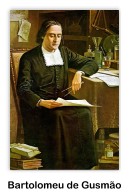
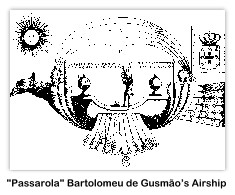 said to have had a remarkable memory and a great command of languages.
said to have had a remarkable memory and a great command of languages.In 1709 he presented a petition to King John V of Portugal, seeking royal favor for his invention of an airship, in which he expressed the greatest confidence. The contents of this petition have been preserved, together with a picture and description of his airship. Developing the ideas of Francesco Lana de Terzi, S.J., Gusmão wanted to spread a huge sail over a boat-like body like the cover of a transport wagon; the boat itself was to contain tubes through which, when there was no wind, air would be blown into the sail by means of bellows. The vessel was to be propelled by the agency of magnets which were to be encased in two hollow metal balls. The public test of the machine, which was set for June 24, 1709, did not take place. According to contemporary reports, however, Gusmão did make several less ambitious experiments with this machine, and was supposedly able to fly one 1 km over Lisbon, landing in Terreiro do Paço.
It is known that Gusmão was working on this principle at the public exhibition he gave before the Court on August 8, 1709, in the hall of the Casa da Índia in Lisbon, when he propelled a ball to the roof by combustion. The king rewarded the inventor by appointing him to a professorship at Coimbra and made him a canon. He was also one of the fifty selected as members of the Academia Real de História, founded in 1720; and in 1722 he was made chaplain to the Court. Gusmão also busied himself with other inventions, but in the meantime continued his work on his airship schemes, the idea for which he is said to have conceived while a novice at Bahia. His experiments with designs for an aeroplane and a hot-air balloon led him to conceive a project for an actual airship, or rather a ship to sail in the air, consisting of a triangular gas-filled pyramid, but he died before he was able to build a craft to this design.
Persecution — One account of Gusmão's work suggests that the Portuguese Inquisition forbade him to continue his aeronautic investigations and persecuted him because of them, but this is probably a later invention. It dates however from at least the end of the 18th century, as the following article in the London Daily Universal Register (later The Times) of October 20, 1786, makes clear:
“By accounts from Lisbon we are assured, that in consequence of the experiments made there with the Montgolfier balloon, the literati of Portugal had been incited to make numerous researches on the subject; in consequence of which they pretend that the honor of the invention is due to Portugal. They say that in 1720, a Brazilian Jesuit, named Bartholomew Gusmão, possessed of abilities, imagination, and address, by permission of John V. fabricated a balloon in a place contiguous to the Royal Palace, and one day, in presence of their Majesties, and an immense crowd of spectators, raised himself, by means of a fire lighted in the machine, as high as the cornice of the building; but through the negligence and want of experience of those who held the cords, the machine took an oblique direction, and, touching the cornice, burst and fell.
The balloon was in the form of a bird with a tail and wings. The inventor proposed to make new experiments, but, chagrined at the raillery of the common people, who called him wizard, and terrified by the Inquisition, he took the advice of his friends, burned his manuscripts, disguised himself, and fled to Spain, where he soon after died in an hospital.
They add, that several learned men, French and English, who had been at Lisbon to verify the fact, had made enquiries at the Carmelite monastery, where Gusmão had a brother, who had preserved some of his manuscripts on the manner of constructing aerostatic machines. Various living persons affirm that they were present at the Jesuit's experiments, and that he received the surname of Voador, or Flying-man.
Contemporary documents do attest that information was laid before the Inquisition against Gusmão, but on quite another charge. The inventor fled to Spain and fell ill of a fever, of which he died in Toledo. He wrote: Manifesto summario para os que ignoram poderse navegar pelo elemento do ar (Short Manifesto for those who are unaware that is possible to sail through the element air, 1709); and Varios modos de esgotar sem gente as naus que fazem agua (Several ways of draining, without people, ships that leak water, 1710); some of his sermons also have been printed.
Legacy — In 1936 an airport was built in Rio de Janeiro, Brazil and named as Bartolomeu de Gusmão Airport. It was built by the Luftschiffbau Zeppelin to handle the operations with the rigid airships Graf Zeppelin and Hindenburg. In 1941 the airport was taken over by the Brazilian Air Force and renamed Santa Cruz Air Force Base. Presently, the airport serving Araraquara, Brazil is also named as Bartolomeu de Gusmão Airport. [1,4]
1710-1719
c. 1712 (St-Germain, France) — In the seventeenth century we do find the first authentic story of man's flight. Charles Allard, a tight-rope walker who lived during the reign of Louis XIV, built a with wings attached to his arms. Charles Allard tries to fly from the Terrase de Saint-Germain to the Bois de Vésinet. This show of courage was by way of entertainment for the monarch. In Louis's eyes the performance was probably judged a success; Charles Allard almost killed himself. The science of aviation was not, however, advanced. [1,6]
- 20 July 1713 (London, England) — Essayist Joseph Addison publishes a satire on flying in the Guardian: “Nothing would be more frequent than to see people flying in at a garret window, or a gallant giving chase to his mistress, like a hawk after a lark.” [1]
1720-1729
- No data
1730-1739
- No data
1740-1749
-
1742 (Paris, France) — The eighteenth century was almost half gone before another spectacular attempt at heavier-than-air flight was made. This was the heroic gesture of the Marquis de Bacqueville. In 1742, he announced that he would fly from his mansion on the Rue des Saints-Pères across the river Seine to the Tuileries Gardens - some five or six hundred feet away. Duly, a large crowd gathered.
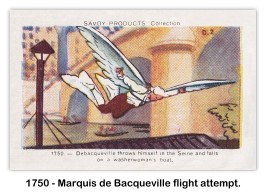 They could see the Marquis with large paddle-shaped wings attached to his hands and feet. The machinery of his flight seemed none too convincing; but the crowd waited patiently, confident of the success of the nobility in performing miracles.
They could see the Marquis with large paddle-shaped wings attached to his hands and feet. The machinery of his flight seemed none too convincing; but the crowd waited patiently, confident of the success of the nobility in performing miracles.
Perhaps the same idea buoyed up the confidence of the Marquis, but the Marquis himself it did not buoy up. He jumped; his arms and legs beat the air frantically. For a moment he seemed to make progress; then he faltered and fell, not into the soft waters of the Seine, but, alas for nobility, onto the deck of a washerwoman's barge anchored in his path. He broke his leg. What happened to his pride was not recorded. He never flew again. [1,3,6]
-
1749 (Scotland) — Alexander Wilson FRSE (1714-1786) was a Scottish surgeon, type-founder, astronomer, mathematician and meteorologist. He was the first scientist to record the use of kites in meteorological investigations.
Wilson was born in St. Andrews, Fife, the son of Patrick Wilson, the town clerk. Alexander was educated at the University of St. Andrews from where he graduated MA in 1733, at the age of 18. He was first apprenticed to a physician in St. Andrews where he became skilled in constructing mercury thermometers in glass. In 1737 he left for London, to make his fortune and found work as assistant to a French surgeon-apothecary, which included caring for his
 patients. During this time he was introduced to Lord Isla who like Wilson was interested in astronomy, and Wilson constructed instruments for Isla during 1738. After visiting a type foundry with a friend in London, he had an idea for making better typefaces. He and his friend John Baine returned to St Andrews in 1739, where they started a type-founding business in 1742.
patients. During this time he was introduced to Lord Isla who like Wilson was interested in astronomy, and Wilson constructed instruments for Isla during 1738. After visiting a type foundry with a friend in London, he had an idea for making better typefaces. He and his friend John Baine returned to St Andrews in 1739, where they started a type-founding business in 1742.The company moved to Camlachie, near Glasgow in 1744. In 1748 he was appointed type-founder to Glasgow University. In the following year the partnership with Baine was dissolved. Later his sons became partners. He supplied types to the Foulis press making possible their beautiful and artistic publications. Among modern typefaces, Fontana, Scotch Roman, and Wilson Greek are based on types cut by Alexander Wilson. His work can be seen, for example, at Examples of Foulis Press Books.
In 1749 Wilson made the first recorded use of kites in meteorology with his lodger, a 23-year-old Glasgow University student Thomas Melvill, who went on to discover sodium light. They measured air temperature at various levels above the ground simultaneously with a train of kites.
With the help of his friend Lord Isla, now the 3rd Duke of Argyle, he was appointed in 1760 to the new chair of practical astronomy at the University of Glasgow, which had recently built the MacFarlane Observatory. Wilson primarily made contributions to astronomy and meteorology, and posited that “what hinders the fixed stars from falling upon one another”, the question that Newton had posed in his Opticks (1704), was that the entire universe rotated around its center. This has been found to be true of the stars of the Galaxy, the then known universe, which rotates around a central black hole. It is not true for the galaxies of the Universe which is expanding.
Wilson noted that sunspots viewed near the edge of the Sun's visible disk appear depressed below the solar surface, a phenomenon referred to as the Wilson effect. When the Royal Danish Academy of Sciences and Letters announced a prize to be awarded for the best essay on the nature of solar spots, Wilson submitted an entry. On 18 February 1772 the Academy presented Wilson with a gold medal for his work on sunspots.
The crater Wilson on the Moon is named for him, Ralph Elmer Wilson and CTR Wilson. [1,7]
1750-1759
-
1750 (Württemburg, Germany) — A miller called Schweikart tries to fly from a mountain with a pair of large taffeta wings. Before a large crowd, he falls to the ground smashing his wings. [1]
-
5 October 1751 (London, England) — Italian Andrea Grimaldi, self-styled priest of dubious reputation, exhibits a flying carriage. The machine, which remains untested, has a complex structure and a wingspan of 22 feet. [1]
-
15 June 1752 (Philadelphia, Pennsylvania) — Benjamin Franklin flies a kite in test - The American scientist, politician and philosopher Benjamin Franklin has made one of the first practical experiments using flight as a tool for scientific investigation. In order to demonstrate his theory relating to the electrical element of lightning, he flew a kite with a moist chord in a thundercloud during a storm.
Benjamin Franklin (1706-1790) was one of the Founding Fathers of the United States. A noted polymath, Franklin was a leading author, printer, political theorist, politician, postmaster, scientist, musician, inventor, satirist, civic activist, statesman, and diplomat. As a scientist, he was a major figure in the American Enlightenment and the history of physics for his discoveries and theories regarding electricity. He invented the lightning rod, bifocals, the Franklin stove, a carriage odometer, and the glass &squo;armonica’. He formed both the first public lending library in America and the first fire department in Pennsylvania.


Among Franklin's discoveries were his investigations of electricity. Franklin proposed that “vitreous” and “resinous” electricity were not different types of “electrical fluid”, as electricity was called then, but the same electrical fluid under different pressures. He was the first to label them as positive and negative respectively, and he was the first to discover the principle of conservation of charge.
In 1750 he published a proposal for an experiment to prove that lightning is electricity by flying a kite in a storm that appeared capable of becoming a lightning storm. On 15 June 1752, Franklin may possibly have conducted his famous kite experiment in Philadelphia, successfully extracting sparks from a cloud. Franklin's experiment was not written up with credit until Joseph Priestley's 1767 History and Present Status of Electricity. The evidence shows that Franklin was insulated, and thusly not in a conducting path, where he would have been in danger of electrocution.
In his writings, Franklin indicates that he was aware of the dangers and offered alternative ways to demonstrate that lightning was electrical, as shown by his use of the concept of electrical ground. If Franklin did perform this experiment, he may not have done it in the way that is often described, flying the kite and waiting to be struck by lightning, as it could have been dangerous. Instead he used the kite to collect some electric charge from a storm cloud, which implied that lightning was electrical. On 19 October 1752, in a letter to England explaining directions for repeating the experiment, Franklin wrote:
“When rain has wet the kite twine so that it can conduct the electric fire freely, you will find it streams out plentifully from the key at the approach of your knuckle, and with this key a phial, or Leiden jar, maybe charged: and from electric fire thus obtained spirits may be kindled, and all other electric experiments [may be] performed which are usually done by the help of a rubber glass globe or tube; and therefore the sameness of the electrical matter with that of lightening completely demonstrated.”
Franklin's electrical experiments led to his invention of the lightning rod. He noted that conductors with a sharp rather than a smooth point were capable of discharging silently, and at a far greater distance. He surmised that this knowledge could be of use in protecting buildings from lightning by attaching “upright Rods of Iron, made sharp as a Needle and gilt to prevent Rusting, and from the Foot of those Rods a Wire down the outside of the Building into the Ground; ... Would not these pointed Rods probably draw the Electrical Fire silently out of a Cloud before it came nigh enough to strike, and thereby secure us from that most sudden and terrible Mischief!” Following a series of experiments on Franklin's own house, lightning rods were installed on the Academy of Philadelphia (later the University of Pennsylvania) and the Pennsylvania State House (later Independence Hall) in 1752.
In recognition of his work with electricity, Franklin received the Royal Society's Copley Medal in 1753 and in 1756 he became one of the few 18th century Americans to be elected as a Fellow of the Society. The cgs unit of electric charge has been named after him: one Franklin (Fr) is equal to one statcoulomb. [1,8]
1760-1769
1764 (Thuringia, Germany) — Angelic transport dismissed as madness - Gardener's son Melchior Bauer has failed in his third attempt to obtain funds for his extraordinary "Cherub Wagon" flying machine. Last year he was rudely rebuffed by King George III of England and King Frederick II of Prussia. Now he has been rejected by his own ruler, Heinrich XI of Reuss. Basing his design on the description of the angels' chariot in Ezekiel's prophecies, Bauer poses to use a signal fixed monoplane wing with dihedral and a separate means of propulsion (a system of flappers worked by the pilot). He suggests take-off from the side of a hill. n ardent Protestant, Bauer had written to the Prussian monarch in an exalted tone, like that of the book of Ezekiel itself. A court official reported: "The fiery fever has turned your head. If you could do that, the king would have you driving around all days of your life in a golden coach ... Are you not fearful of your sanity? But I pity you from the heart for having fixed such a mad scheme into your head, for to all appearances you are a sensible fellow." [1]
1766 (Clapham, England) — British scientist finds inflammable air - By mixing iron, tin and zinc shavings with oil of vitriol (sulfuric acid) in his laboratory at Clapham, south of London, British scientist Henry Cavendish has discovered a gas which burns very readily. He calls it phlogiston [inflammable air] or hydrogen [water producer] because when combined with oxygen, it makes water. Scientists have long believed that
 fire is a special manifestation, or fluid, flowing out an as yet undiscovered material. They have long sought out phlogiston, which they know must be lighter than air, because of the fact that fire and smoke rise up from a burning solid. The principal; element behind them must, therefore, be lighter too. Cavendish has weighed his newly discovered gas and found it to be one-tenth the weight of air. Moreover, it has been observed that many substances are heavier after combustion than they were before; the conclusion is that they have released their phlogiston, with its “negative weight.” This negative weight could be harnessed to pull heavier objects up into the air. [1]
fire is a special manifestation, or fluid, flowing out an as yet undiscovered material. They have long sought out phlogiston, which they know must be lighter than air, because of the fact that fire and smoke rise up from a burning solid. The principal; element behind them must, therefore, be lighter too. Cavendish has weighed his newly discovered gas and found it to be one-tenth the weight of air. Moreover, it has been observed that many substances are heavier after combustion than they were before; the conclusion is that they have released their phlogiston, with its “negative weight.” This negative weight could be harnessed to pull heavier objects up into the air. [1]
1770-1779
c.1770 (Etampes, France) — Canon Pierre Desforges builds a pair of feather wings for a flying experiment. The experiment fails because the peasant to whom the wings are fixed refuses to go through with the attempt. [1]
1782 (Italy) — Scientist Tiberius Cavallo fills soap bubbles with hydrogen to demonstrate the lifting powers of the gas, but an attempt to lift hydrogen-filled bladders fails. [1]
1780-1789
November 1782 (Avignon, France) — Joseph-Michel Montgolfier (1740-1810) and Jacques-Étienne Montgolfier (1745-1799) were the inventors of the Montgolfière-style hot air balloon, globe aérostatique.
Of the two brothers, it was Joseph who first contemplated building machines. Joseph made his first definitive experiments in November 1782 while living in the city of Avignon. He reported, some years later, that he was watching a fire one evening while contemplating one of the great military issues of the day-an assault on the fortress of Gibraltar, which had proved impregnable by both sea and land. Joseph mused on the possibility of an air assault using troops lifted by the same force that was lifting the embers from the fire. He believed that contained within the smoke was a special gas, which he called Montgolfier Gas, with a special property he called levity.
As a result of these musings, Joseph set about building a box-like chamber 3×3×4 ft out of very thin wood and covering the sides and top with lightweight taffeta cloth. He crumpled and lit some paper under the bottom of the box. The contraption quickly lifted off its stand and collided with the ceiling. Joseph then recruited his brother to balloon building by writing the prophetic words, “Get in a supply of taffeta and of cordage, quickly, and you will see one of the most astonishing sights in the world.” The two brothers then set about building a contraption three times larger in scale (27 times larger in volume). The lifting force was so great that they lost control of their craft on its very first test flight on 14 December 1782. The device floated nearly two kilometers (about 1.2 mi). It was destroyed after landing by the “indiscretion” of passersby.[10]
25 April 1783 (Annonay, France) — Old shoes fueled brothers' first attempt — French makers Etienne Montgolfier (1745-1799) and Joseph Montgolfier (1740-1810) demonstrate a hot-air balloon capable of lifting a man. The 35-foot wide, paper-lined linen structure balloon was equipped with a brazier burning straw, old shoes and rotten meat. The balloon flew to an altitude of approximately 1,000 feet and landed three-quarters of a mile away.
Étienne said it would have flown further if the smoke had not escaped through the button holes which held the balloon together. The brothers innocent animals up, then on October 15 electrocute roseate became the first man to leave the ground in a tethered balloon. [1]
-
4 June 1783 (Annonay, France) — After their successful flights in April, the Montgolfier brothers decided to make a public demonstration of a balloon in order to establish their claim to its invention. They constructed a globe-shaped balloon of sackcloth with three thin layers of paper inside. The envelope could contain nearly 790 m³ (28,000 ft³) of air and weighed
 225 kg (500 lb). It was constructed of four pieces, the dome and three lateral bands, held together by 1,800 buttons. A reinforcing fish net of cord covered the outside of the envelope.
225 kg (500 lb). It was constructed of four pieces, the dome and three lateral bands, held together by 1,800 buttons. A reinforcing fish net of cord covered the outside of the envelope.On 4 June 1783, they flew this craft as their first public demonstration at Annonay, France. The historic flight took place in front of a group of dignitaries from the Etats particulars. The flight covered 2 km (1.2 mi), lasted 10 minutes, and had an estimated altitude of 1,600-2,000 m (5,200-6,600 ft). Word of their success quickly reached Paris. Étienne went to the capital to make further demonstrations and to solidify the brothers' claim to the invention of flight. Joseph, given his unkempt appearance and shyness, remained with the family. Étienne was the epitome of sober virtues … modest in clothes and manner. [3,10]
19 September 1783 (Versailles, Paris, France) — Étienne Montgolfier, in collaboration with the successful wallpaper manufacturer Jean-Baptiste Réveillon, constructed a 37,500 ft³ (1,060 m³) envelope of taffeta coated with a varnish of alum (which has fireproofing properties). The balloon was sky blue and decorated with golden flourishes, signs of the zodiac, and suns. The design showed the intervention of Réveillon. On 19 September 1783. the Aerostat Réveillon was flown with the first living beings in a basket attached to the balloon: a sheep called “Montauciel” (Climb-to-the-sky), a duck and a rooster. The sheep was believed to have a reasonable approximation of human physiology. The duck was expected to be unharmed by being lifted aloft. It was included as a control for effects created by the aircraft rather than the altitude. The rooster was included as a further control as it was a bird that did not fly at high altitudes. This demonstration was performed before a crowd at the royal palace in Versailles, before King Louis XVI of France and Queen Marie Antoinette. The flight lasted approximately eight minutes, covered two miles (3 km), and obtained an altitude of about 1,500 feet (460 m). The craft landed safely after flying. [10]
15 October 1783 (Faubourg Saint-Antoine, Paris, France) — With the successful demonstration at Versailles, and again in collaboration with Réveillon, Étienne Montgolfier started construction of a 60,000 ft³ (1,700 m³) balloon for the purpose of making flights with humans. The balloon was about seventy-five feet tall and about fifty feet in diameter. It had rich decorative touches supplied by Réveillon. The color scheme was gold figures on a deep blue Background. Fleur-de-lis, signs of the zodiac, and suns with Louis XVI's face in the center interlaced with the royal monogram in the central section graced the majestic machine. Red and blue drapery and golden eagles were at the base of the balloon. It is fitting that Étienne Montgolfier was the first human to lift off the earth, making at least one tethered flight from the yard of the Réveillon workshop in the Faubourg Saint-Antoine. It was most likely on October 15, 1783. A little while later on that same day, Pilâtre de Rozier became the second to ascend into the air, to an altitude of 80 feet (24 m), which was the length of the tether. [10]
21 November 1783 (Butte-aux-Cailles, Paris, France) — On 21 November 1783, the first free flight by humans was made by Pilâtre de Rozier, together with an army officer, the Marquis d'Arlandes. The flight began from the grounds of the Château de la Muette (close to the Bois de Boulogne (park) in the western outskirts of Paris. They flew aloft about 3,000 feet (910 m) above Paris

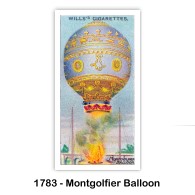
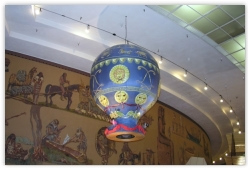 for a distance of nine kilometers. After 25 minutes, the machine landed between the windmills, outside the city ramparts, on the Butte-aux-Cailles. Enough fuel remained on board at the end of the flight to have allowed the balloon to fly four to five times as far. However, burning embers from the fire were scorching the balloon fabric and had to be daubed out with sponges. As it appeared it could destroy the balloon, Pilâtre took off his coat to stop the fire. [3, 10]
for a distance of nine kilometers. After 25 minutes, the machine landed between the windmills, outside the city ramparts, on the Butte-aux-Cailles. Enough fuel remained on board at the end of the flight to have allowed the balloon to fly four to five times as far. However, burning embers from the fire were scorching the balloon fabric and had to be daubed out with sponges. As it appeared it could destroy the balloon, Pilâtre took off his coat to stop the fire. [3, 10]1 December 1783 (Paris, France) — Professor Jaques Charles, a young physicist, made the first flight in a hydrogen-filled balloon. Charles was accompanied by Noel Roberts, one of the brothers who had built the balloon. Charles and Roberts flew 27 miles on this trip. Later, Charles took off on a solo flight and became the first person to
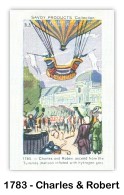 ascend solo in a balloon. He reached an altitude of approximately 10,000 feet. [1,3]
ascend solo in a balloon. He reached an altitude of approximately 10,000 feet. [1,3]16 January 1784 (United States) — Airborne troops proposed by Benjamin Franklin in reporting on the first balloon ascents. [11]
4 June 1784 (Lyon, France) — Madame Elisabeth Thible became the first woman to make an untethered balloon flight. She was so thrilled by the experience that she burst into song. The balloon she rode in was built by the Montgolfier Brothers. [1]
24 June 1784 (Baltimore, Maryland, USA) — Edward Warren age 13, makes the first tethered balloon ascent in the United States. He volunteered for the flight after the craft was unable to lift its builder, Peter Carnes. [1]
15 September 1784 (London, England), — Italian diplomat Vincenzo Lunardi makes the first ascent in a hydrogen balloon in Britain. [1]
19 September 1784 (Paris/Beuvry, France) — Anne-Jean Robert, Nicolas-Louis Robert and Colin Hullin fly La Carolina, a hydrogen balloon, 186 km from Paris to Beuvry. [2,3]
4 October 1784 (Oxford, England) — James Sadler became the first British aeronaut when he makes a flight in a Montgolfière-type balloon. The balloon was 170-feet in circumference. [1]
30 November 1784 (London, England) — First ascent by an American abroad, by Dr. John Jefferies, physician, with French aeronaut Blanchard, at London. [11]
7 January 1785 (Kent, England) — Frenchman Jean-Pierre Blanchard and American Dr. John Jeffries made the first crossing of the English Channel by balloon. [1]

1790-1799
9 January 1793 (Philadelphia, Pennsylvania, USA) — Flamboyant French aeronaut Jean-Pierre Blanchard took off from the town's Walnut Street prison yard in the first piloted hydrogen balloon ascent in the United States of America. After a 46-minute flight, Blanchard landed 15 miles away and presented his “passport” to an illiterate farmer. [1]
2 April 1794 (Paris, France) — France's ruling Committee of Public Safety establishes the Compagnie d'Aérostiers (Balloonists' Company), the first military air service. [1]
26 June 1794 (Fleurus, France) — Two months after the formation of the world's first airborne military service, French forces outwitted their Austrian adversaries by observing them from a balloon. The Balloon L'Entreprenant, in the charge of scientist Captain Coutelle and with General Morlot acting as observer, remained tethered aloft throughout the engagement, which lasted ten hours. [1]
22 October 1797 (France) — First successful parachute descent from a balloon made by Frenchman André Jacques Garnerin (1769-1823). He descended from a balloon that was at an altitude of approximately 3,000 feet.
Born in Paris, André-Jacques Garnerin (1769-1823) was the inventor of the “frameless” parachute. His early experiments were based on umbrella-shaped devices. He was captured by British troops during the first phase of the Napoleonic Wars (1792-1797), turned over to the Austrians and held a prisoner in Buda, Hungary for three years. After his release, Garnerin became involved with the
 flight of hot air balloons. He carried out the first jump with a Silk parachute on October 22, 1797 at Parc Monceau, Paris. Garnerin's first parachute resembled a closed umbrella before he ascended, with a pole running down its center and a rope running through a tube in the pole, which connected it to the balloon. Garnerin rode in a basket attached to the bottom of the parachute. At a height of approximately 3,000 feet (900 m) he severed the rope that connected his parachute to the balloon. The balloon continued skyward while Garnerin, with his basket and parachute, fell. The basket swung during descent, then bumped and scraped when it landed, but Garnerin emerged uninjured. His wife Jeanne-Geneviève was the first female parachutist; as no real material parachute can sustain its entire flight without some positive above-zero glide ratio, then for some, if not almost all of her descent was in a gliding parachute (subset of hang gliders) and thus she was the best candidate for being the first woman hang glider rider. [3,12]
flight of hot air balloons. He carried out the first jump with a Silk parachute on October 22, 1797 at Parc Monceau, Paris. Garnerin's first parachute resembled a closed umbrella before he ascended, with a pole running down its center and a rope running through a tube in the pole, which connected it to the balloon. Garnerin rode in a basket attached to the bottom of the parachute. At a height of approximately 3,000 feet (900 m) he severed the rope that connected his parachute to the balloon. The balloon continued skyward while Garnerin, with his basket and parachute, fell. The basket swung during descent, then bumped and scraped when it landed, but Garnerin emerged uninjured. His wife Jeanne-Geneviève was the first female parachutist; as no real material parachute can sustain its entire flight without some positive above-zero glide ratio, then for some, if not almost all of her descent was in a gliding parachute (subset of hang gliders) and thus she was the best candidate for being the first woman hang glider rider. [3,12]
Works Cited
- Gunston, Bill, et al. Chronicle of Aviation. Liberty, Missouri: JL Publishing Inc., 1992. 14-17
- Wikipedia, Timeline of Aviation — 18th Century
- Shupek, John (photos and card images), The Skytamer Archive. Skytamer.com, Whittier, CA
- Wikipedia, Bartolomeu de Gusmão
- Wikipedia, Joseph Addison
- Hodgins, Eric and Magoun, F. Alexander. Sky High, The Story of Aviation. Boston: Little, Brown and Company, 1930
- Wikipedia, Alexander Wilson
- Wikipedia, Benjamin_Franklin
- Wikipedia, Henry Cavendish
- Wikipedia, Montgolfier Brothers
- Parrish, Wayne W. (Publisher). "United States Chronology". 1962 Aerospace Yearbook, Forty-Third Annual Edition. Washington, DC: American Aviation Publications, Inc., 1962, 446-469.
- Wikipedia, André-Jacques Garnerin
Copyright © 1998-2018 (Our 20th Year) Skytamer Images, Whittier, California
ALL RIGHTS RESERVED


























